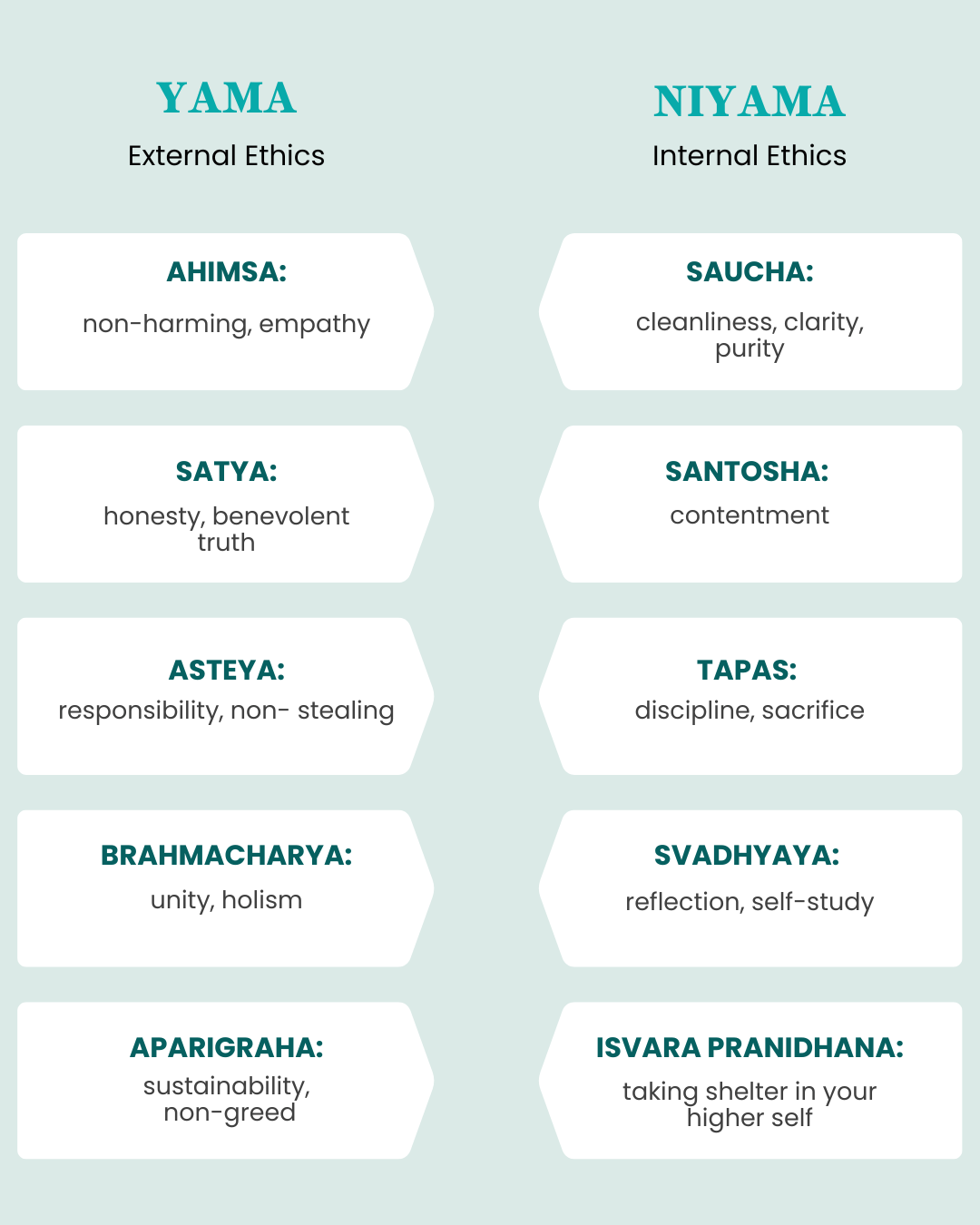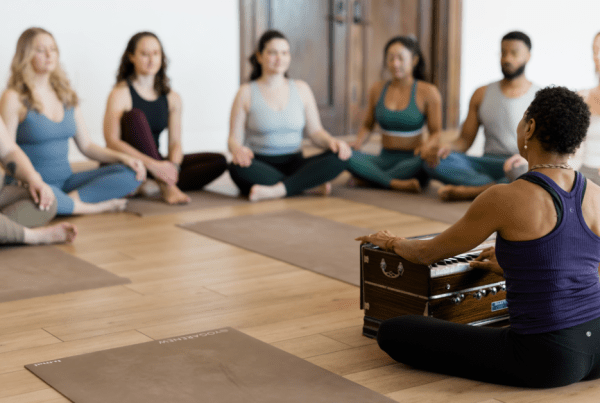
If you are a yoga teacher or yoga practitioner, it is likely you’ve heard of the 8-limbed path of yoga. The 8-limbed path, or Asthanga, is a roadmap through ethics, mental clarity, physical health and ultimately spiritual enlightenment. They are a series of interconnected steps drawn from diverse yogic traditions by Patanjli in his Yoga Sutras which is considered to be the foundational text of modern yoga. The yoga sutras are comprised of many more aphorisms than the 8 limbs, which begin in book 2 (2.29) of the text.
The 8-limbs of Yoga are as follows:
- Yama (moral discipline)
- Niyama (aspirational principles)
- Asana (physical postures)
- Pranayama (breathing technique)
- Pratyahara (detachment)
- Dharana (concentration)
- Dhiyana (reflection)
- Samadhi (total absorption or bliss/enlightenment)
The path is organized in a stepwise fashion, but this blog post is specifically dedicated to the first two limbs, Yama and Niyama. These two limbs are concerned with providing the skills and level of awareness to live joyfully and fully in relation to ourselves, others, and the environment. They are considered to be the ethical guidelines in which to live and access our highest capacity as humans.
What does Yama and Niyama mean?
In English, Yama is translated to “restraint or discipline.” The Yamas are broken down into 5 disciplines which can be incorporated into one’s life to put themselves in right relation with the outside world. Niyama is translated to “observances.” The Niyamas are also broken down into 5 disciplines which can be incorporated into one’s life to observe if they are living in right relation with the inner world.
The Yamas can be thought of as ethical guidelines for how to deal with ourselves (disciplines), while the Niyamas can be thought of as ethical guidelines for how to deal with others (observances).
Table of Contents:
What are the 5 Yamas?
Patanjali’s Yoga Sutras are a set of aphorisms that have been revisited with deeper commentary and analysis in countless books. In her book, “The Yamas & Niyamas,” Deborah Adele describes the Yamas and Niyamas as jewels of wisdom to guide us towards living more joyfully. Grasping the first five jewels and skillfully incorporating them into life contributes to life itself feeling more spacious, enjoyable, and free. Relationships become smoother, work becomes less of a hassle, and we start to realize how fun life can truly be.
The 5 Yamas are as follows:
- Non-violence (Ahimsa)
- Truthfulness (Satya)
- Non-stealing (Asteya)
- Non-excess (Brahmacharya)
- Non-attachment (Aparigraha)
What is Ahimsa?
Ahimsa is the first Yamas and is the first practice within the 8-limbed path of yoga. So you can say it’s quite an important part of the Yogic way of living. Without practicing non-violence, all other tenets of the 8-limbed path are essentially null. Ahimsa means non-violence and this is in reference to oneself, others, and the environment.
So you mean, not hurting or harming anyone or anything?
Yes. Ahimsa means to do no harm to ourselves or another with our actions, behaviors, or words. Harmful words and behaviors can sting just as much, if not sometimes more than a physical action of violence. When we practice non-violence, we are being guided towards compassion, love, and acceptance of ourselves and others.
Ahimsa also guides us towards overcoming fear, self-doubt, and insecurities by exuding courage, tending to oneself’s wants and needs, and by fiercely practicing true self-love. When ahimsa is the undercurrent of all actions we are given the opportunity to learn compassion and dissolve any divides within and between ourselves and others.
How to practice Ahimsa:
- Do one new thing daily for 1 month.
- Notice where in your life you feel depleted and try to give yourself what you might be lacking – exercise, a yoga class, asking for help, eating healthy.
- Acknowledge when you are lacking compassion towards another. Try listening to another instead of automatically giving advice. Notice where you may be judging someone else instead of using compassion to understand their situation.
What is Satya?
Satya means living life based on truthfulness.
So you mean, not telling lies?
Yes, but satya goes deeper than that. Satya guides us towards honesty with ourselves and others in the name of love, self-expression, and growth. Being honest, or being real with ourselves or another, may not always be the easiest thing to do but it’s what allows us to live with integrity in our lives and in our relationships. To live with integrity means to live in a way that truly upholds the highest version of ourselves. This means respecting ourselves, upholding our values, and loving ourselves and others enough to give feedback that creates space for growth and course correction.
Satya and Ahimsa actually go hand in hand. It’s possible that telling the truth could hurt someone’s feelings, but if you’re seeking to be real with someone and if you’re genuinely doing it in the name of love it’s possible to give feedback that can be received with an open heart.
How to practice Satya:
- Observe where you might be choosing to withhold information from someone else because you don’t want to embarrass them or hurt their feelings. Notice if there is an opportunity to be real and truthful.
- Acknowledge the areas of your life where you feel you are stifling yourself. Be honest with yourself and notice if you’re making excuses for why you are holding yourself back. See if you can be in full-expression mode.
- Write down 1 pattern or belief which is no longer serving you but that you have continued to allow in your life. Note why you believe this pattern is still present and indicate to yourself why you’d like it to change.
What is Asteya?
Asteya means to live in a non-stealing manner.
As in, I can’t steal anything from the store?
While Asteya does encompass not stealing someone else’s material possessions, it also involves non-stealing of one’s time, energy, resources (aside from material items), and efforts…including your own. When we make an appointment with someone and are running late, we are stealing time from another. When we make the decision to scroll for hours and hours on social media instead of tending to a work project which has a deadline, we are stealing our own time and our own efforts away from the task which needs to be done. Asteya also guides us towards acknowledgement that we are visitors on this planet, and that nothing actually belongs to us. When we claim the land and the resources from this Earth, we are actually stealing from the planet that we live on.
In order to put ourselves in right relation with ourselves, others, and the planet in terms of stealing, it requires that we once again, hold ourselves with integrity and hold ourselves accountable. It requires honesty and effort to build a life we want, which is hopefully that of joy and peacefulness, on a solid foundation of our own true labors of love.
How to practice Asteya:
- Notice when you are stealing time, energy, or resources from someone else. This could be you “stealing the spotlight,” or you running late to a meeting with someone for no plausible reason. It could also be from making a careless mistake then expecting someone else to rectify the mistake.
- Try to intentionally uphold the ways in which you can navigate to not steal time, energy, or resources from another. This could require letting someone else speak or have the final word, leaving early for a meeting, or slowing down so you can diligently complete your work.
- Notice when you are claiming something as your own, when it actually belongs to the Earth. Think about where you live or the things you have. See if you shift into a state of gratitude for the things you have “borrowed.”
What is Brahmacharya?
Brahmacharya presents living of life of non-excess and/or non-greed. This yama is often connected to celibacy or abstinence from sex. It is true that this is one aspect of Brahmacharya, but in a more broad way of describing it Brahmacharya refers to acknowledging and taming all of our desires. By doing so, we are better able to view every aspect of life as sacred and nourishing rather than everything being ours for the taking and indulging.
Oftentimes we move past the point of being “just enough” into a place of excess which leads us to overdoing many things including eating, sex, material possessions, etc. We can even overdo our spiritual practices working to get it just right potentially becoming obsessed with whatever it is that we are working towards. Sometimes it can be to the point that we can’t enjoy anything else around us, or things are moving too fast that we can’t quite catch each moment. When we take the time to really slow down and treat every moment, every thing, and every one as sacred we give ourselves the opportunity to be present. This is the major tenet of Brahmacharya, to slow down enough, to live within a space of non-excess, so that we can truly feel alive with all that is around us.
How to practice Brahmacharya:
- Notice when you are living in excess. This can be in material possessions, it can be in your energy, or in your pleasure. Try to increase your awareness so that you can indicate the point at which you pass from true nourishment to overdoing it.
- Pay close attention to your body and notice when you can choose rest over activity. Perhaps sign up for a yin class instead of a vinyasa class. Perhaps opt to take a rest day between days of planned workouts or classes. Choose to move slowly through your morning instead of rushing out the door.
- Ponder and journal about the things and people which you deem to be “sacred” within your life. What are the things and who are the people which you appreciate and which you find to contribute to your feelings of aliveness?
What is Aparigraha?
Aparigraha means to live with non-attachment. This might be one of the most well-known of the Yamas, even if one does not fully understand the Yamas. To live with non-attachment does not mean to not care about the things, people, and opportunities in your life. It means to live in a way that if those things, people, and opportunities were to disappear that you would be perfectly okay. Essentially, aparigraha teaches us that it’s okay to love deeply and it’s okay to let go completely.
Death is probably our most profound teacher in the name of non-attachment. We are all guaranteed death in this lifetime and that goes for our loved ones who surround us. This does not mean that we should avoid loving anyone deeply. The wounds of losing someone to death, or to a breakup (or any adjacent circumstance), can cut deeply and will most likely inflict some level of pain and hardship. To live with non-attachment does not mean that we will not experience pain or difficulty throughout life, but it encourages us to love despite the pain that comes when we inevitably lose people (or things or pets, etc.).
The harder we try to hold on to things and people, the more those things and people have a grip over us. So when we give ourselves the chance to let go, we give ourselves the chance to be free. Free of expectation, fear, worry, anxiety, etc. Living with non-attachment is the acknowledgement that nothing belongs to us and absolutely nothing in this lifetime lasts forever. When we can recognize and find peace within that, which is reality, our capacity for gratitude and appreciation increases substantially. The time that we spend with our loved ones becomes even sweeter because we know that every relationship (besides the one with ourselves) is finite. Establishing true connection and intentionally bringing presence into our relationships (which can only be done if we can do so within ourselves) is what will ultimately facilitate peaceful non-attachment in our lives.
How to practice Aparigraha:
- Non-attachment does not only occur with other beings (people, pets, etc.), it can happen with material possessions. Notice what material possessions, perhaps your home or car, that you are attached to. Ponder on the feelings you might experience should those things disappear.
- Notice the people in your life who you feel you are attached to. Are you afraid of losing them (whether to death or a breakup)? And if so, how might this be contributing to your relationship with them?
- Attempt to think about what would happen if you were to lead with love in all your relationships. Try to be fully present, with an open heart, and no expectations in all your interactions for 1 full week.
What are the 5 Niyamas?
Once the first five jewels have been grasped, one may begin to practice the second set of five jewels – the Niyamas. The Niyamas walk us into a more subtle realm of the self guiding us towards ultimate peace, trust, and surrender.
The 5 Niyamas are as follows:
- Saucha (Purity)
- Santosha (Contentment)
- Tapas (Discipline)
- Svadhyaya (Self-study)
- Ishvara Pranidhana (Surrender)
What is Saucha?
Saucha means purity, or cleanliness. Cleanliness of one’s body is included in Saucha (a shower, bathing, washing up) but it also encompasses purity of one’s thoughts and energy. A focus of yoga in general is to clear the lens from which we view out of so that we can see clearly. This allows us to perceive ourselves and others without judgment, bias, or expectation, aka to perceive reality. The process by which we do this takes time and effort and is more than just “switching from negative thoughts to positive thoughts.” This requires that we acknowledge whatever the dominant “negative” thoughts or patterns are so that we can identify their origin and intentionally work at untangling said thoughts or patterns. This requires consistent effort because whatever patterns we have are most likely where we feel most comfortable. The process of purifying our thoughts and the way we interact with ourselves and the world will likely require moving outside our comfort zones, which will incur much discomfort as we learn how to navigate people and situations in new and more aligned ways. This is absolutely a great place to consider working with outside help, like a licensed therapist, if you feel you’re having trouble identifying patterns or working on changing old patterns/beliefs on your own.
How to practice Saucha:
- Take 1 hour to clean your home and notice how the cleanliness of your external environment affects the cleanliness of your internal environment.
- Begin to purify your inner dialogue. You can use different techniques such as talk therapy, journaling, meditation, etc. Try to create a better story for yourself and repeat it over and over again replacing any damaging or intrusive storylines.
- Attend a yoga class and for the entire 60-75 minutes, just let yourself be. Don’t force any themes or intentions, just simply notice your breath, body, and movements.
What is Santosha?
Santosha means contentment. It invites us to appreciate each moment as it is and to not seek fulfillment outside of ourselves and what we already have.
What if I want more for myself or want to achieve something specific?
Santosha does not mean to not work hard or to give up on your dreams to stay stagnant. But it does mean to not give up your own feelings of validity, love, or acceptance to the things you’re working towards. Meaning, the way we view ourselves and the level of love and joy we find within our lives comes from the well of our own being as opposed to some external source whether that be a relationship, an amount of money, a job, or any accolade.
The foundation of self-love, self-worth, and self-acceptance amongst other things is so important as we establish our goals and begin working our way towards said goals. In this way, contentment comes along every step of the journey. When we learn true contentment, we’re never seeking anything outside of ourselves no matter where we are in our journey, and instead we learn to look inward when we feel discontent. We can be single and looking for a relationship and feel content. We can know our job is out of alignment and be looking for a new job and feel content. We can be in school and still working towards a degree or certification and not working yet and still feel content. The key to living with contentment is to view yourself and life as complete. Nothing outside of us will make us whole, we are the only ones who can create feelings of wholeness.
How to practice Santosha:
- Notice where in your life you are seeking something outside of yourself, whether that be a relationship, a job, or new material possession. Notice any accompanying thoughts and feelings that come with that seeking and write down any observations.
- When doing something you do not enjoy (such as a work task), notice if you harbor any resistance by noticing your bodily sensations, thoughts, emotions, and energy. Try to notice any active and vocal complaints. Attempt to simply do the task without a story benign attached to it.
- For one whole day, ask yourself to fully lean into trust accepting each moment as it comes.
What is Tapas?
Tapas means self-discipline. To encourage self-discipline means to hold ourselves up to our own standards of living, even when conditions are not ideal.
Discipline sounds harsh. What about compassion?
While discipline may have a harsh-sound connotation, discipline within ourselves and the practices which support our wellbeing, is the only thing that will allow us to be consistent and our practices be embodied. The goal is not to be overly disciplined to the point that we’re doing a 75-minute power yoga class after a night of no sleep and a chaotic day, but to be disciplined enough to commit ourselves to the overall practice of yoga (reflect on all 8 limbs). Compassion is highly important in this way. Not every day is going to be easy to practice. There are going to be periods of turbulence and there are going to be periods of ease. Discipline gives us the heat needed to show up no matter what the circumstances are and guides us towards holding ourselves accountable for our choices.
How to practice Tapas:
- Notice your daily choices with food, time spent, people you choose to surround yourself with, even television shows you choose to watch. Observe your energy when you feel in alignment vs. out of alignment.
- Identify a time and place to tend to your practice every single day for 1 whole month. This can be in the morning, noon, or night but try to pick a time that you know you can commit to every day. Designate a quiet space that you can make your “sacred space” which is meant specifically for practice. Commit to said practice for 1 whole month.
- Notice your mindset around discipline. Is it harsh? Does your mindset around discipline cause you to overdo things, or try to make things “perfect”? Attempt to shift your mindset to that of simply showing up each day and note your observations towards yourself.
What is Svadhyaya?
Svadhyaya means self-study. It invites us to look within the depths of our own being to truly know ourselves as a foundation for aligning our lives according to our true nature.
So if I buy a bunch of yoga books and read them on my own, does that count?
Yes, taking the initiative to buy books and read through appropriate resources (such as this blog and others posted on YogaRenew) is included in Svadhyaya. But it does go beyond just reading a book, or attending a training or workshop. Svadhyaya encourages deep curiosity and introspection about the Self so that we can unpack all the boxes which we put ourselves into including our expectations, our limiting beliefs, projections, and judgements. As we begin our journey inward, it is expected that discomfort will arise. As we start to unpack the boxes, we may recognize some ugly things…things which no longer serve us and who we are becoming. It’s our duty to look at these things with open eyes and open hearts. Working on all the preceding Yamas and Niyamas will help us in this stage with being kind, honest, efficient, etc. in our journey to know thyself. The more consistent we are in looking at past patterns and current beliefs in service of updating our own operating systems, the better we become at being observers of our lives and really watching ourselves as we navigate every and all situations. The more open we are to what we observe, the smoother the transition to update ourselves and our lives.
How to practice Svadhyaya:
- Notice when you are projecting your “stuff” onto another instead of taking responsibility for your own behaviors and actions. Instead of blaming others, listen and see where you can take ownership.
- Write down 3 limiting beliefs, thoughts, or values which are no longer serving you and that you wish to update. Write down your updated beliefs and take ownership of incorporating them into your life.
- Become a true witness to your own life: Try to view the way you navigate situations either on your own or with others with open eyes, an open mind, and an open heart. Afterwards, write down your observations without a story attached.
What is Isvara Pranidhana?
Isvara Pranidhana means surrender. Here we are invited to acknowledge that there is a divine force, greater than us, which is at play to support us throughout our lives.
What if I don’t believe in God?
You don’t have to believe in God or a particular deity to trust that a greater force exists. That force could be the universe, fate, or even your SELF. The purpose of surrender is to accept that everything outside of ourselves is out of our control. Learning to surrender, means learning to stop resisting reality and to stop fighting against the things which we do not particularly like, enjoy, or currently understand. The moment that we can begin to release that which is out of our control, is the moment that we are truly free to enjoy the waves of life which are guaranteed to have ups and downs. It’s at this moment that every moment becomes one that is nourishing and life-giving. In order to surrender, you don’t have to give up, stop doing what you’re doing, or seize all action. But you might consider noticing places of tension in your life. Notice where you are resisting by noticing your attitude and sensations within the body towards certain situations or people. Notice where you feel you’re stifling yourself and see if you can trust that you’re being given the opportunity to rise up. Ask yourself to view each moment as it is, and each person as they are, without trying to control or change it or them. In that way, let go and let yourself surrender to life.
How to practice Isvara Pranidhana:
- Attend a yoga class and genuinely try to surrender in Savasana, meaning commit to the pose, attempt to remain still, and trust that you can let go.
- In your interactions with others, see if you can let people just be themselves without trying to change or manipulate them. See if you can choose to love them as they are.
- Notice the moments you are being given a chance to speak your truth or show up as a fuller version of yourself. Try to lean into trusting that you are being presented an opportunity for a reason and see if you can take said opportunity. Note what happens.
Learn more about Isvara Pranidhana
Sources: The Yamas & Niyamas by Deborah Adele










